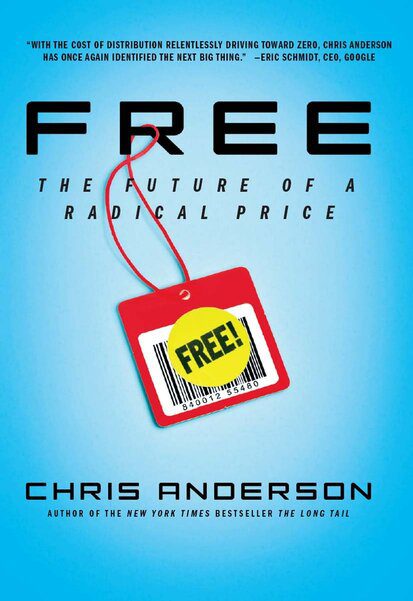The Web’s Lesson: When Something Halves in Price Each Year, Zero Is Inevitable.
In Free: The Future of a Radical Price, English-American author, entrepreneur and former Editor in chief of Wired magazine, examines the freemium strategy where products and services are initially given to customers for free, and how businesses can profit more in the long run.
The costs associated with the growing online economy are trending toward zero at an incredible rate.
Anderson argues that in many instances businesses can profit more from giving things away than they can by charging for them. Far more than a promotional gimmick, Free is a business strategy that may well be essential to a company’s survival.
In Free, Anderson makes a compelling argument for exploring free as a business model by offering a part of the product free (Freemium) and other part of the product such as other features and upsell(s) are paid for by other customers (premium) or advertisers. He cite examples of organizations that have and are exploring free as a business model such as Loss leaders (Gillette, Jell-O), Ryan Air, Amazon Free Shipping, Zappos two way free shipping, Open Source software, Better Place Free Car etc.
Free
Most of us depend on one or more Google services every day, but they never show up on our credit card. No meter ticks as you use Facebook. Wikipedia costs you nothing. Twenty-first-century free is different from twentieth-century free. Somewhere in the transition from atoms to bits, a phenomenon that we thought we understood was transformed. “free” became free.
Loss Leadership
King Gillette pioneered loss leadership by selling razors at a low margin to partners, such as banks, who would typically “give them away as part of promotions. Gillette made its real profit from the high margin on the blades.
A few billion blades later, this business model is now the foundation of entire industries: Give away the cell phone, sell the monthly plan; make the video game console cheap and sell expensive games; install fancy coffeemakers in offices at no charge so you can sell managers expensive coffee sachets.
Bits vs atoms Economy
While the last century’s free was a powerful marketing method, this century’s free is an entirely new economic model. This new form of free is based on the economics of bits, not atoms. It is a unique quality of the digital age that once something becomes software, it inevitably becomes free—in cost, certainly, and often in price.
In the atoms economy, which is to say most of the stuff around us, things tend to get more expensive over time. But in the bits economy, which is the online world, things get cheaper. The atoms economy is inflationary, while the bits economy is deflationary.
Cross-Subsidy
Sometimes people are paying indirectly for products. That free newspaper you’re reading is supported by advertising, which is part of a retailer’s marketing budget, which is built into its profit margin, which you (or someone around you) will ultimately pay for in the form of more expensive goods. You’re also paying with a bit of your time and, by being seen reading that newspaper, your reputation. The free parking in the supermarket is paid for by the markup on the produce, and the free samples are subsidized by those who shell out for the paid versions.
Within the broad world of cross-subsidies, free models tend to fall into four main categories:
FREE 1: DIRECT CROSS-SUBSIDIES
WHAT’S FREE: Any Product That Entices You to Pay for Something Else.
FREE TO WHOM: Everyone Willing to Pay Eventually, One Way or Another.
FREE 2: THE THREE-PARTY MARKET
WHAT’S FREE: Content, Services, Software, and More.
FREE TO WHOM: Everyone.
FREE 3: FREEMIUM
WHAT’S FREE: Anything That’s Matched with a Premium Paid Version.
FREE TO WHOM: Basic Users.
FREE 4: NONMONETARY MARKETS
WHAT’S FREE: Anything People Choose to Give Away with No Expectation of Payment.
FREE TO WHOM: Everyone.
Substitution Effect
If a resource becomes too scarce and expensive, it provides an incentive to look for an abundant replacement, which shifts demand away from the scarce resource.
Complements
Complements are products or services that tend to be consumed together, such as beer and salted peanuts, or cars and car loans. For Google, almost anything that happens online can be seen as a complement to its main business. Every blog post put up is more information for Google’s Web crawler to index, to help Google give better search results. Every click in Google Maps is more information about consumer behavior, and every email in Gmail is a clue to our human network of connections, all of which Google can use to help invent new products or just sell ads better.
The interesting thing about the consumption of complementary products is that they tend to rise in tandem. The more people use the Internet, the better it is for Google’s core business.
FREE RULES: The Ten Principles of Abundance Thinking
1. If it’s digital, sooner or later it’s going to be free.
In a competitive market, price falls to the marginal cost. The Internet is the most competitive market the world has ever seen, and the marginal costs of the technologies on which it runs—processing, bandwidth, and storage—get closer and closer to zero every year. free becomes not just an option but an inevitability. Bits want to be free.
2. Atoms would like to be free, too, but they’re not so pushy about it.
Outside of the digital realm, marginal costs rarely fall to zero. But free is so psychologically attractive that marketers will always find ways to invoke it by redefining their business to make some things free while selling others. It’s not really free—it’s probably you paying sooner or later—but it’s often compelling all the same. Today, by creatively expanding the definition of their industry, companies from airlines to cars have found ways to make their core product free by selling something else.
3. You can’t stop free.
In the digital realm you can try to keep free at bay with laws and locks, but eventually the force of economic gravity will win. What that means is that if the only thing stopping your product from being free is a secret code or a scary warning, you can be sure that there’s someone out there who will defeat it. Take free back from the pirates, and sell upgrades.
4. You can make money from free.
People will pay to save time. People will pay to lower risk. People will pay for things they love. People will pay for status. People will pay if you make them (once they’re hooked). There are countless ways to make money around free: free opens doors, reaching new consumers. It doesn’t mean you can’t charge some of them.
5. Redefine your market.
Ryanair’s competitors were in the airline seat business. It decided to be in the travel business instead. The difference: There are dozens of ways to make money in travel, from car rentals to subsidies from destinations hungry for tourists. The airline made its seats cheap, even free, to make more money around them.
6. Round down.
If the cost of something is heading to zero, free is just a matter of when, not if. Why not get there first, before someone else does? The first to free gets attention, and there are always ways to turn that into money. What can you make free today?
7. Sooner or later you will compete with free.
Whether through cross-subsidies or software, somebody in your business is going to find a way to give away what you charge for. It may not be exactly the same thing, but the price discount of 100 percent may matter more. Your choice: Match that price and sell something else, or ensure that the differences in quality overcome the differences in price.
8. Embrace waste.
If something is becoming too cheap to meter, stop metering it. From having flat fees to no fees, the most innovative companies are those who see which way the pricing trends are going and get ahead of them. “Your voice mail inbox is full” is the death rattle of an industry stuck with a scarcity model in a world of capacity abundance.
9. free makes other things more valuable.
Every abundance creates a new scarcity. A hundred years ago entertainment was scarce and time plentiful; now it’s the reverse. When one product or service becomes free, value migrates to the next higher layer. Go there.
10. Manage for abundance, not scarcity.
Where resources are scarce, they are also expensive—you have to be careful how you use them. Thus traditional top-down management, which is all about control to avoid expensive mistakes. But when resources are cheap, you don’t have to manage the same way. As business functions become digital, they can also become more independent without risk of sinking the mothership. Company culture can shift from “Don’t screw up” to “Fail fast.”
FREEMIUM TACTICS
FINDING A FREEMIUM MODEL THAT WORKS FOR YOU
1. Time limited (Thirty days free, then pay. This is the Salesforce model.)
Upside: Easy to do, low risk of cannibalization.
Downside: Many potential customers will be unwilling to commit enough to give the software a real test, since they know that if they don’t pay they’ll get no benefit after thirty days.
2. Feature limited (Basic version free, more sophisticated version paid. This is the model that Automattic uses with hosted WordPress.)
Upside: Best way to maximize reach. When customers convert to Paid, they’re doing it for the right reason (they understand the value of what they’re paying for) and are likely to be more loyal and less price sensitive.
Downside: Need to create two versions of the product. If you put too many features in the free version, not enough people will convert. If you put too few, not enough will use it long enough to convert.
3. Seat limited (Can be used by up to some number of people for free, but more than that is paid. This is the Intuit QuickBooks model.)
Upside: Easy to implement. Easy to understand.
Downside: Might cannibalize the low end of the market.
4. Customer type limited (Small and young companies get it free; bigger and older companies pay. This is the model used by Microsoft’s BizSpark, where companies less than three years old and under $1 million in revenues get Microsoft’s business software free.)
Upside: Charges companies according to their ability to pay. Gets fast-growing companies early.
Downside: Complicated and hard-to-police verification process.
The Web is built mostly on two non-monetary units—attention (traffic) and reputation (links)—both of which benefit hugely from free content and services. And it’s a pretty simple matter to convert either of those two currencies into cash, as a glance at Google’s balance sheet makes clear.
Inevitability of Free
Just as music and computer software is becoming primarily an online market, so will games. And once you switch from shipping atoms (plastic boxes and disks) to transmitting bits, free becomes inevitable. Over the next decade, this $10 billion industry will shift from primarily a traditional packaged goods business to an online business built on entry prices of zero.
All the Best in your quest to get Better. Don’t Settle: Live with Passion.



Comments are closed.